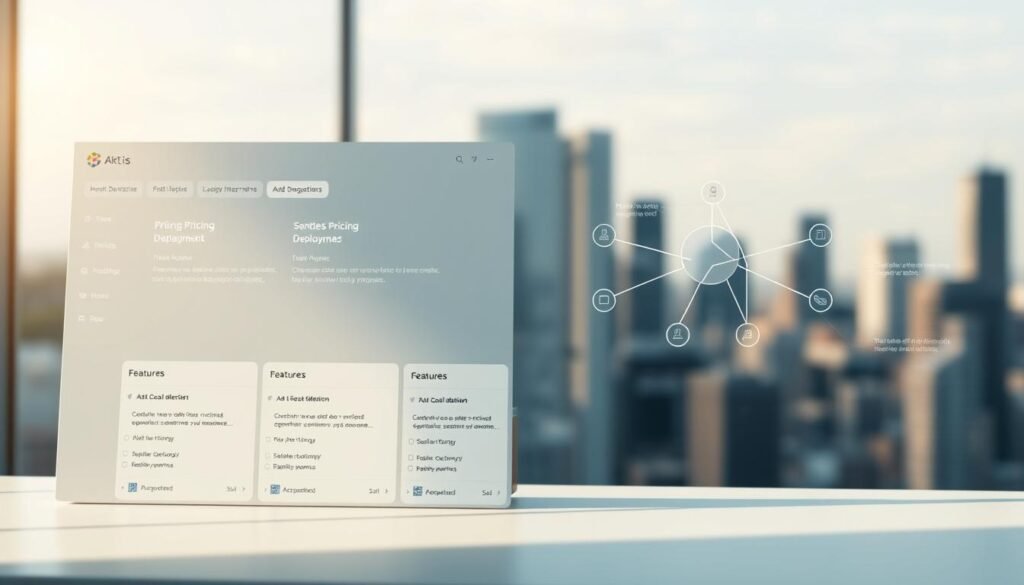Fact: The average cost of a data breach reached $4.88 million in 2024 — a 10% jump year over year.
This rise makes clear why modern protection must cover apps, endpoints, network, cloud, and IoT. Our approach brings a unified platform that boosts visibility across the full attack surface.
We focus on measurable gains: lower mean time to detection and response, stronger prevention at the edge and in runtime, and improved security posture. That way, organizations can sustain operations and reduce risk to data and reputation.
Why it matters: threats are more frequent and complex, and compliance penalties grow. A coherent protection strategy speeds detection, centralizes governance, and shortens time to value for public sector and commercial buyers alike.
Key Takeaways
- Data breaches are costly—prevention pays off financially and operationally.
- A unified platform improves visibility across endpoints, network, and cloud.
- Outcome-driven delivery lowers detection and response times.
- Coverage spans application, endpoint, network, cloud, and IoT attack surfaces.
- Ready for U.S. organizations and public sector procurement paths.
Why U.S. Organizations Choose Our Security Solutions Today
Public and commercial buyers favor single-console platforms that shorten procurement cycles and deliver compliance-ready documentation for rapid deployment.
Continuous monitoring and automated response let lean teams run enterprise-grade protection without the hires. That reduces alert fatigue and manual overhead while improving day-to-day operations.
Centralized management and shared telemetry increase visibility across cloud, on-prem, and remote endpoints. Teams investigate faster and prioritize true risk to high-value assets.
Consolidation cuts tool sprawl, lowers total cost of ownership, and speeds time to value. Integration readiness with SIEM, SOAR, and ITSM preserves existing investments and streamlines incident workflows.
- Reduced dwell time and lower incident costs through adaptive analytics.
- Scalable controls from midmarket to enterprise as workloads grow.
- Field-proven onboarding that accelerates user adoption and operational readiness.
The Business Impact of Modern Threats and the Need for Protection
Rising incident costs and repeated service disruptions are forcing leaders to re-evaluate their risk posture. The average cost of a data breach reached $4.88 million in 2024, a 10% year-over-year increase.
Rising breach costs and operational disruption
That financial hit ties directly to downtime, recovery, and lost revenue. Supply chain interruptions and service outages erode customer trust and hurt margins.
Insider threats now drive over 43% of breaches, increasing pressure on monitoring and access controls.
Expanding attack surface across remote work and cloud
Hybrid and remote models enlarge exposure across endpoints and cloud environments. Multi-stage attacks often chain phishing, privilege escalation, and persistence to bypass legacy defenses.
“Prevention spending typically costs far less than remediation, legal fines, and reputational damage.”
| Impact | Example | Business Consequence |
|---|---|---|
| Financial | $4.88M average breach cost (2024) | Direct loss, recovery costs |
| Operational | Supply chain outage | Service disruption, lost customers |
| Regulatory | GDPR / HIPAA / PCI DSS reporting | Fines, audit findings |
ROI favors prevention: integrated detection and response cuts dwell time and containment costs. Unified visibility and governance help organizations allocate resources and lower overall risk.
cybersecurity solutions
A layered defense ties app, endpoint, network, cloud, and IoT controls into a cohesive program. This makes coverage practical and lowers blind spots across hybrid estates.
End-to-end coverage from endpoints to cloud environments
Core categories include application protection (WAF, API, DDoS, SAST/DAST/IAST/RASP/SCA), endpoint tech (EPP, EDR, XDR), network controls (NGFW, NIDS, NAC), cloud posture (CASB, CSPM, CWPP), and IoT security.
Standardized tools act as building blocks that scale with mergers, cloud moves, and new use cases.
Unified strategy for visibility, governance, and compliance
Consolidated telemetry and correlated detection logic raise signal fidelity and speed investigations.
Policy alignment across environments enforces consistent controls and simplifies audits. Integration with SIEM, SOAR, and IT workflows operationalizes security at scale and trims tool redundancy.
| Category | Example Technologies | Primary Benefit |
|---|---|---|
| Application | WAF, API security, DAST | Protects web apps and APIs |
| Endpoint | EPP, EDR, XDR | Detects and remediates device threats |
| Cloud & Network | CASB, CSPM, NGFW | Controls posture and access |
| IoT & Governance | Device monitoring, policy engine | Ensures auditability and compliance |
Application Security Built for Modern Applications
Applications today demand layered controls that protect traffic, APIs, and client code.
WAF, bot defense, and DDoS for web-scale threats
WAF controls inspect HTTP/S traffic to stop injections, XSS, and business logic abuse at scale. They filter and audit requests so malicious payloads never reach the app runtime.
Bot defense blocks credential stuffing, account takeover, and scraping that erode revenue and brand trust.
DDoS protection absorbs volumetric traffic at the edge to keep sites online during attacks.
API and client-side safeguards
API security discovers endpoints, enforces auth, and applies policies to protect data flows and users.
Client-side protection monitors third-party scripts and prevents Magecart-style skimming of payment fields.
Shift-left testing and runtime defenses
SAST, DAST, and IAST catch flaws early in the SDLC while SCA inventories open-source risk and license issues.
RASP provides runtime blocking without code changes, reducing critical defects in production and lowering incident rates.
Vendor platforms like Imperva unify analytics across the stack so teams see attacks and outcomes in one place.
Data Security and Governance You Can Trust
Protecting sensitive information requires an end-to-end program that finds, classifies, and controls data across every system. Continuous discovery and simple policy management reduce shadow data and speed audit readiness.
Sensitive discovery, classification, and risk analysis
Discovery maps where critical records live. Classification tags sensitivity so access rules apply correctly.
Data risk analysis spots anomalous access and ranks incidents for fast remediation.
- Full lifecycle: discovery, classification, access control, monitoring, remediation.
- Anomaly detection to prioritize true risk and reduce false positives.
- Integration with SIEM for centralized alerts and audit trails.
Compliance and governance mapped to real controls
Practical compliance maps HIPAA, PCI DSS, and GDPR to control objectives and reporting templates. Governance defines ownership, stewardship, and retention to protect information and improve quality.
Cloud data and database security across hybrid environments
Cloud discovery gives visibility into managed databases and workloads across environments. Database controls like activity monitoring, masking, and universal policy management reduce exposure.
Providers such as Imperva offer cloud data security, database security, and data risk analysis to cut noncompliant access and speed audits.
Endpoint Security with EPP, EDR, and XDR
Endpoint security must combine fast prevention with continuous insight to stop modern attacks targeting remote and on-prem devices.
Behavioral detection, one-click remediation, and device visibility
EPP offers point-in-time prevention while EDR provides continuous monitoring for ransomware, fileless malware, and polymorphic threats.
XDR extends correlation across layers and fuses identity and endpoint telemetry to reveal stealthy attack chains.
Behavioral detection finds unknown malware and lateral movement without relying on signatures. One-click remediation and rollback speed containment and cut downtime.
Managed detection and response for 24/7 protection
Managed detection and response delivers 24/7 monitoring, expert triage, and threat hunting tied to single-console management.
Rapid-deploy agents minimize user disruption and speed time to protection for remote workers and field devices.
- Outcomes: reduced dwell time and stronger resilience against ransomware.
- Integration with IT management streamlines patching, posture checks, and policy enforcement.
Cloud and Network Security for Distributed Environments
Protecting distributed estates starts with consistent control across cloud services and the network that connects them. A focused mix of cloud posture tools and network controls keeps risk low while operations stay agile.
CASB, CSPM, and CWPP for multi-cloud control and posture management
CASB discovers unsanctioned SaaS, enforces access rules, and prevents data loss across cloud apps. It helps teams map who accesses what and where sensitive data flows.
CSPM finds misconfigurations, produces compliance reports, and enforces guardrails across multiple cloud accounts. It reduces drift and speeds audit readiness.
CWPP protects VMs, containers, and serverless workloads with consistent policy across public and private clouds. Runtime controls and image scanning ensure uniform posture.
NGFW, NIDS, segmentation, and secure access
NGFW provides application-aware controls, IPS, VPN support, and encrypted traffic inspection at the edge and perimeter. NIDS adds wide visibility and anomaly detection for east-west and north-south traffic.
Segmentation limits lateral movement to reduce blast radius. Zero-trust aligned access for remote users and branches enforces least privilege and strong session controls.
Unified platform views correlate cloud and network telemetry for faster triage and automated remediation—tagging, quarantine, and policy updates—so teams keep a consistent posture across distributed environments.
Zero Trust Architecture for Secure Access Everywhere
A single access model that never assumes trust gives teams a clear path to secure every user and device.
Identity-first controls, least privilege, and continuous verification
Verify explicitly by tying authentication to identity, context, and risk signals. Use adaptive MFA and role-based rules to enforce least privilege.
Continuous verification checks device posture and session behavior so access is re-evaluated in real time.
Extending zero trust across applications, endpoints, and SaaS
Apply consistent policy engines across apps, endpoints, and cloud services to keep controls uniform. Microsegmentation and device posture checks limit lateral movement and shrink blast radius.
“Assume breach: verify every request and limit privileges to reduce exposure.”
- Identity-first strategies: MFA, adaptive policies, risk scoring.
- Device checks: posture validation and enforced remediation.
- Integration patterns: IAM, EDR/XDR, and SASE for policy enforcement.
- Compliance mapping: granular access logs and audit trails.
| Goal | Approach | Outcome |
|---|---|---|
| Reduce attack surface | Least privilege + microsegmentation | Fewer lateral breaches |
| Faster anomaly detection | Real-time identity and device signals | Quicker containment |
| Compliance | Fine-grained access logs | Clear audit evidence |
AI-Powered Threat Detection, Response, and Visibility
Artificial intelligence now powers faster, more accurate threat detection across endpoints, network, and cloud. Adaptive models learn normal behavior and surface risky deviations with contextual scoring.
Real-time analytics correlate signals to map attack chains. This visibility speeds investigation and helps teams see where containment matters most.
Real-time analytics, automated playbooks, and attack surface insights
Automated playbooks orchestrate containment steps—endpoint isolation, user lockouts, and firewall rule updates—so action happens at machine speed. Vendors like SentinelOne and Palo Alto deliver orchestration that ties these actions to policy.
Attack surface insights inventory assets and flag misconfigurations. Teams prioritize fixes by risk and exposure instead of chasing low-value alerts.
- Continuous improvement: models retrain on new patterns to reduce false positives.
- Integrations: SIEM/SOAR and ITSM link evidence and ticketing for audit-ready trails.
- Governance: human-in-the-loop approvals guard high-impact responses.
By applying artificial intelligence to detection and guiding automated response, organizations cut manual workload and shorten mean time to response. The result is clearer visibility and measurable operational gains.
Security Operations: XDR, SIEM Integration, and Orchestration
Analysts move faster when logs, alerts, and runbooks appear together in one console.
XDR consolidates telemetry from endpoints, network devices, and cloud workloads. It raises signal fidelity and surfaces high‑confidence detections across domains.
Consolidated posture across endpoints, network, and cloud
SIEM platforms like IBM QRadar aggregate logs at scale for correlation and compliance reporting. They give a single timeline for audits and investigations.
Integrations with SIEM and SOAR to accelerate investigations
SOAR tools such as Cortex XSOAR automate playbooks to reduce handling errors and speed response. Automation runs low-risk tasks first, then scales up as playbook maturity improves.
- Unified visibility reduces context switching for analysts.
- Integrations: EDR, NGFW, IAM, and cloud platforms for end‑to‑end coverage.
- Governance workflows: case management, evidence retention, and KPIs for management review.
| Capability | Role | Outcome |
|---|---|---|
| XDR | Correlates multi‑layer telemetry | Fewer false positives, faster triage |
| SIEM | Logs and compliance reporting | Audit-ready evidence |
| SOAR | Automates orchestration | Reduced mean time to response |
| Hunting & Analytics | Proactive detection | Uncovers stealthy campaigns |
Outcome: integrated tools strengthen security posture and improve operations efficiency through measurable KPIs and continuous tuning after incidents.
Compliance, Governance, and Framework Alignment
Mapping standards to controls helps enterprises show consistent, auditable practices. Alignment to NIST, ISO 27001, COBIT, and ITIL builds a defensible foundation for compliance and oversight.
Mapping frameworks to practical controls
NIST offers flexible control families for risk-based programs. ISO 27001 defines an information management system with clear audit criteria.
COBIT connects business goals to IT controls. ITIL ties service management to business outcomes and change control.
| Framework | Strength | Measure |
|---|---|---|
| NIST | Risk-based controls | Control maturity, risk score |
| ISO 27001 | Auditable ISMS | Audit findings, gaps closed |
| COBIT / ITIL | Business‑IT alignment | Service KPIs, process SLAs |
Policy management enforces controls across hybrid estates and ties to change management. Evidence collection and reporting give auditors the logs and artifacts they expect for compliance.
Information classification and retention rules reduce risk and speed reviews. Roles like CISO, CIO, and CSO own governance, while operations ensure day‑to‑day control.
“Continuous assurance through metrics and assessments turns policy into measurable outcomes.”
Partner Ecosystem and Platforms You Already Use
A strong partner ecosystem lets teams leverage familiar tech while adding centralized workflows and telemetry.
Seamless interoperability: integrations with Palo Alto Networks enable network enforcement and playbook orchestration via Cortex XSOAR and WildFire. Cisco ties in through SecureX and Talos for fast threat enrichment and automated context.
Vendor integrations that speed outcomes
IBM Security feeds QRadar for unified logging and Guardium for data controls to support audit needs. Trend Micro links XDR and Cloud One to protect cloud workloads with coordinated policies.
CrowdStrike Falcon shares telemetry to enrich endpoint and identity detections. SentinelOne Singularity contributes behavioral AI and one-click remediation for rapid containment.
Open connectors and modular deployment: platform-agnostic APIs and modular adapters let teams deploy gradually and keep existing contracts intact. Public sector buyers benefit from government distributors and established contract vehicles for fast procurement.
| Vendor | Primary Integration | Benefit |
|---|---|---|
| Palo Alto Networks | Firewalls, Cortex XSOAR, WildFire | Network enforcement + orchestration |
| Cisco | SecureX, Umbrella, Talos | Threat enrichment and fast context |
| IBM Security | QRadar, Guardium | Log correlation and data protection |
| Trend Micro / CrowdStrike / SentinelOne | XDR, Cloud One, Falcon, Singularity | Cloud workload, endpoint intelligence, behavioral AI |
Outcome: faster deployments, lower integration risk, and unified workflows that accelerate user adoption and measurable results.
Public Sector and Regulated Industries
Federal and state agencies need procurement pathways that match mission timelines and compliance gates. Programs benefit when pre‑packaged offerings align to government contract vehicles and acquisition rules.
Procurement‑ready packages and compliance posture
Vendors provide procurement‑ready packaging that maps to GSA schedules and agency aggregators. This speeds purchases and reduces legal review cycles.
Architectures are built to meet compliance and governance demands. Reference designs include audit trails, evidence collectors, and templates for authority to operate (ATO).
Coverage across identity, data, mobile, and OT
Offerings span identity and access, data protection, mobile security, and IoT/OT systems to cover mission‑critical assets.
Device inventory and control are central for government fleets and critical infrastructure. Continuous monitoring and reporting support incident reporting and ATO renewal.
Interoperability, risk, and operational readiness
Interagency interoperability and cross‑domain support ease information sharing and coordinated response across departments.
Risk‑informed controls prioritize mission assurance and resilience. Role‑based access and least‑privilege enforcement reduce exposure while enabling trusted operations.
- Procurement-ready packaging aligned to contract vehicles
- Compliance-aligned templates for audits and ATOs
- Device inventory, mobile, and OT coverage for critical systems
- Continuous monitoring, reporting, and incident coordination
- Partnerships that accelerate rollout and simplify buying
Pricing, Deployment Options, and Getting Started
Flexible pricing and clear deployment paths make adoption predictable and fast.
We offer modular packages that scale by org size and systems in scope. Choose seat-based, capacity, or outcome pricing tied to measured KPIs.

Deployment options include SaaS, hybrid, and on‑prem components that operate from a single console. Open APIs ease integration with existing tools and environments.
Time to value is accelerated with guided onboarding, policy templates, and automation playbooks. Expect a pilot to show measurable gains within weeks, not months.
- Managed tiers: 24/7 monitoring, triage, and incident response to extend small teams.
- Integration: adapters for SIEM, ITSM, and IAM reduce disruption during rollout.
- Training: enablement tracks upskill staff and embed repeatable management routines.
- Assessment and architecture design
- Pilot deployment with policy templates
- Scale-out across environments and review
| Offer | Deployment | Support | Expected ROI |
|---|---|---|---|
| Starter | SaaS single‑tenant | Business hours onboarding | Faster baseline coverage, lower tool count |
| Enterprise | Hybrid (SaaS + on‑prem) | 24/7 managed operations | Reduced incident costs, consolidated systems |
| Managed | Fully managed platform | Dedicated SOC + SLAs | Rapid response and predictable TCO |
SLAs, success metrics, and support channels are defined up front so outcomes tie to reviews. Track mean time to detection, containment rates, and operational cost savings.
Schedule a readiness workshop to get a tailored deployment roadmap and cost estimate. That step turns procurement into a concrete plan for faster response and better management.
Conclusion
Conclusion
A unified approach to visibility and policy turns noisy alerts into clear priorities for action. Integrated security solutions that link apps, endpoints, network, data, and cloud cut risk and raise operational speed.
Align governance to frameworks like NIST and ISO to prove controls and improve your security posture. Apply zero trust to limit access, reduce blast radius, and preserve trust across the enterprise.
Scale with modular architectures for hybrid and cloud environments and use AI-driven detection and orchestration to speed response. Partner-led services accelerate maturity and deliver measurable gains: faster detection, fewer incidents, and lower total cost.
Next step: contact our team for an assessment, roadmap, and phased plan that fits your sector and mission.
FAQ
What types of protection do you offer for endpoints, networks, and cloud environments?
We provide end-to-end coverage that includes endpoint protection (EPP), detection and response (EDR/XDR), next‑generation firewalls (NGFW), intrusion detection, cloud posture management (CSPM), cloud workload protection (CWPP), and CASB controls to secure devices, networks, and multi‑cloud platforms.
How does zero trust improve access control for distributed teams?
Zero trust enforces identity‑first controls, least privilege access, and continuous verification so users and devices prove trust before each session. This reduces lateral movement and applies consistent policies across applications, SaaS, endpoints, and remote workforces.
Can you integrate with our existing security stack like Palo Alto Networks or CrowdStrike?
Yes. The platform supports integrations with major vendors such as Palo Alto Networks, Cisco, IBM, Trend Micro, CrowdStrike, and SentinelOne to consolidate telemetry, enrich threat intelligence, and automate response workflows.
What role does AI play in threat detection and response?
AI and machine learning provide real‑time analytics, behavior baselining, and automated playbooks to surface anomalies, prioritize alerts, and accelerate containment. This improves visibility across the attack surface and reduces mean time to detect and respond.
How do you protect web applications, APIs, and client‑side code?
Protection includes web application firewalls (WAF), bot defense, DDoS mitigation, API security controls, and client‑side protections. We also support shift‑left testing with SAST, DAST, IAST, RASP, and software composition analysis to secure applications throughout development and runtime.
What capabilities support data protection and regulatory compliance?
We offer sensitive data discovery, classification, data risk analysis, database protection, and cloud data controls. Policies and reporting map to standards like HIPAA, PCI DSS, and GDPR, helping you demonstrate governance and meet audit requirements.
Do you provide managed detection and response (MDR) services?
Yes. Our managed detection and response teams deliver 24/7 monitoring, threat hunting, and incident containment with one‑click remediation options to reduce operational burden on internal teams.
How do you help organizations improve their security posture?
We consolidate telemetry from endpoints, network devices, cloud workloads, and applications into a unified view for posture management. Automated assessments, risk scoring, and prioritized remediation guidance enable continuous improvement and governance alignment.
What deployment models are available for different sized organizations?
Deployment options include cloud‑native services, hybrid deployments for on‑prem and cloud workloads, and appliance or virtualized firewalls. Flexible models suit enterprises, SMBs, and public sector buyers with procurement‑ready packages.
How do you detect and respond to advanced attacks like supply‑chain or fileless threats?
We combine behavioral detection, endpoint telemetry, network forensics, and threat intelligence to detect anomalous patterns and lateral movement indicative of advanced attacks. Automated playbooks and XDR capabilities accelerate containment and forensic investigation.
What reporting and metrics will we receive for compliance and executive reporting?
Dashboards provide executive summaries, compliance mapping to frameworks like NIST and ISO 27001, incident timelines, mean time to detect/contain metrics, and detailed audit logs to support governance and regulatory reporting.
How do you secure APIs and microservices in modern cloud applications?
API security includes schema validation, authentication and authorization controls, runtime protection, anomaly detection, and API discovery. Combined with CSPM and CWPP, these controls protect microservices across hybrid cloud environments.
Can your platform scale for global enterprises with satellite offices and remote workforces?
Yes. The architecture supports distributed deployments, cloud edge controls, secure access service edge (SASE) patterns, and centralized policy management to maintain consistent security for global teams and remote users.
What are the first steps to get started with a risk assessment or pilot?
Initial steps include a discovery session, asset inventory and attack surface assessment, prioritized risk scoring, and a short pilot that validates detection, protection, and integration with existing SIEM or SOAR tools.
How do you reduce alert fatigue and improve SOC efficiency?
We use correlation engines, risk‑based alert prioritization, enrichment with threat intelligence, and automated playbooks to reduce false positives. SIEM and SOAR integrations streamline investigations and speed response.



